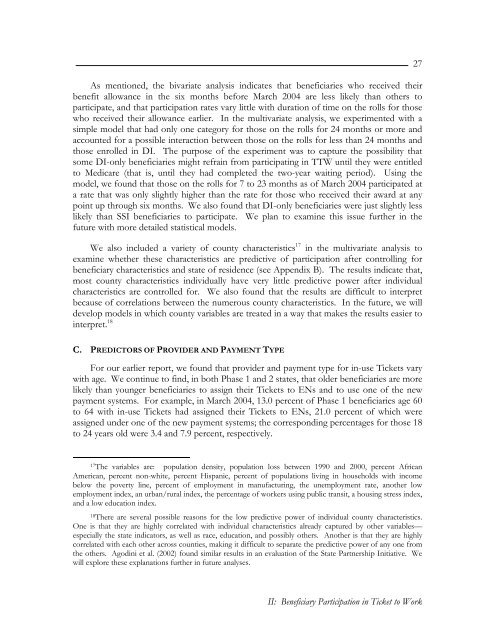Evaluation of the Ticket to Work Program, Implementation ...
Evaluation of the Ticket to Work Program, Implementation ...
Evaluation of the Ticket to Work Program, Implementation ...
You also want an ePaper? Increase the reach of your titles
YUMPU automatically turns print PDFs into web optimized ePapers that Google loves.
As mentioned, <strong>the</strong> bivariate analysis indicates that beneficiaries who received <strong>the</strong>irbenefit allowance in <strong>the</strong> six months before March 2004 are less likely than o<strong>the</strong>rs <strong>to</strong>participate, and that participation rates vary little with duration <strong>of</strong> time on <strong>the</strong> rolls for thosewho received <strong>the</strong>ir allowance earlier. In <strong>the</strong> multivariate analysis, we experimented with asimple model that had only one category for those on <strong>the</strong> rolls for 24 months or more andaccounted for a possible interaction between those on <strong>the</strong> rolls for less than 24 months andthose enrolled in DI. The purpose <strong>of</strong> <strong>the</strong> experiment was <strong>to</strong> capture <strong>the</strong> possibility thatsome DI-only beneficiaries might refrain from participating in TTW until <strong>the</strong>y were entitled<strong>to</strong> Medicare (that is, until <strong>the</strong>y had completed <strong>the</strong> two-year waiting period). Using <strong>the</strong>model, we found that those on <strong>the</strong> rolls for 7 <strong>to</strong> 23 months as <strong>of</strong> March 2004 participated ata rate that was only slightly higher than <strong>the</strong> rate for those who received <strong>the</strong>ir award at anypoint up through six months. We also found that DI-only beneficiaries were just slightly lesslikely than SSI beneficiaries <strong>to</strong> participate. We plan <strong>to</strong> examine this issue fur<strong>the</strong>r in <strong>the</strong>future with more detailed statistical models.We also included a variety <strong>of</strong> county characteristics 17 in <strong>the</strong> multivariate analysis <strong>to</strong>examine whe<strong>the</strong>r <strong>the</strong>se characteristics are predictive <strong>of</strong> participation after controlling forbeneficiary characteristics and state <strong>of</strong> residence (see Appendix B). The results indicate that,most county characteristics individually have very little predictive power after individualcharacteristics are controlled for. We also found that <strong>the</strong> results are difficult <strong>to</strong> interpretbecause <strong>of</strong> correlations between <strong>the</strong> numerous county characteristics. In <strong>the</strong> future, we willdevelop models in which county variables are treated in a way that makes <strong>the</strong> results easier <strong>to</strong>interpret. 1827C. PREDICTORS OF PROVIDER AND PAYMENT TYPEFor our earlier report, we found that provider and payment type for in-use <strong>Ticket</strong>s varywith age. We continue <strong>to</strong> find, in both Phase 1 and 2 states, that older beneficiaries are morelikely than younger beneficiaries <strong>to</strong> assign <strong>the</strong>ir <strong>Ticket</strong>s <strong>to</strong> ENs and <strong>to</strong> use one <strong>of</strong> <strong>the</strong> newpayment systems. For example, in March 2004, 13.0 percent <strong>of</strong> Phase 1 beneficiaries age 60<strong>to</strong> 64 with in-use <strong>Ticket</strong>s had assigned <strong>the</strong>ir <strong>Ticket</strong>s <strong>to</strong> ENs, 21.0 percent <strong>of</strong> which wereassigned under one <strong>of</strong> <strong>the</strong> new payment systems; <strong>the</strong> corresponding percentages for those 18<strong>to</strong> 24 years old were 3.4 and 7.9 percent, respectively.17 The variables are: population density, population loss between 1990 and 2000, percent AfricanAmerican, percent non-white, percent Hispanic, percent <strong>of</strong> populations living in households with incomebelow <strong>the</strong> poverty line, percent <strong>of</strong> employment in manufacturing, <strong>the</strong> unemployment rate, ano<strong>the</strong>r lowemployment index, an urban/rural index, <strong>the</strong> percentage <strong>of</strong> workers using public transit, a housing stress index,and a low education index.18 There are several possible reasons for <strong>the</strong> low predictive power <strong>of</strong> individual county characteristics.One is that <strong>the</strong>y are highly correlated with individual characteristics already captured by o<strong>the</strong>r variables—especially <strong>the</strong> state indica<strong>to</strong>rs, as well as race, education, and possibly o<strong>the</strong>rs. Ano<strong>the</strong>r is that <strong>the</strong>y are highlycorrelated with each o<strong>the</strong>r across counties, making it difficult <strong>to</strong> separate <strong>the</strong> predictive power <strong>of</strong> any one from<strong>the</strong> o<strong>the</strong>rs. Agodini et al. (2002) found similar results in an evaluation <strong>of</strong> <strong>the</strong> State Partnership Initiative. Wewill explore <strong>the</strong>se explanations fur<strong>the</strong>r in future analyses.II: Beneficiary Participation in <strong>Ticket</strong> <strong>to</strong> <strong>Work</strong>
















